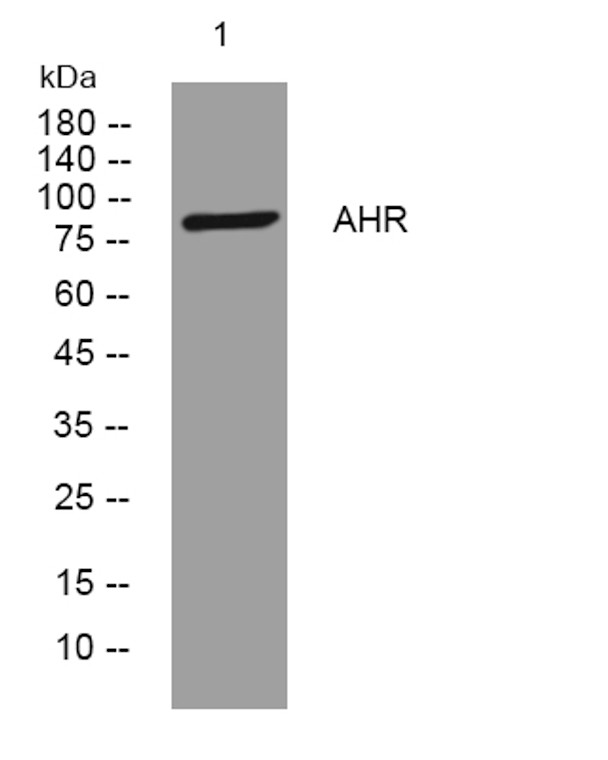| Host: |
Rabbit |
| Applications: |
WB/IF |
| Reactivity: |
Human/Mouse/Rat/Fish |
| Note: |
STRICTLY FOR FURTHER SCIENTIFIC RESEARCH USE ONLY (RUO). MUST NOT TO BE USED IN DIAGNOSTIC OR THERAPEUTIC APPLICATIONS. |
| Short Description: |
Rabbit polyclonal antibody anti-Aryl hydrocarbon receptor (408-458 aa) is suitable for use in Western Blot and Immunofluorescence research applications. |
| Clonality: |
Polyclonal |
| Conjugation: |
Unconjugated |
| Isotype: |
IgG |
| Formulation: |
Liquid in PBS containing 50% Glycerol, 0.5% BSA and 0.02% Sodium Azide. |
| Purification: |
The antibody was affinity-purified from rabbit antiserum by affinity-chromatography using epitope-specific immunogen. |
| Concentration: |
1 mg/mL |
| Dilution Range: |
WB 1:500-2000IF ICC 1:100-500 |
| Storage Instruction: |
Store at-20°C for up to 1 year from the date of receipt, and avoid repeat freeze-thaw cycles. |
| Gene Symbol: |
AHR |
| Gene ID: |
196 |
| Uniprot ID: |
AHR_HUMAN |
| Immunogen Region: |
408-458 aa |
| Specificity: |
This antibody detects endogenous levels of AHR at Human/Mouse/Rat |
| Immunogen: |
Synthesized peptide derived from the human AHR at the amino acid range 408-458 |
| Post Translational Modifications | Mono-ADP-ribosylated, leading to inhibit transcription activator activity of AHR. |
| Function | Ligand-activated transcription factor that enables cells to adapt to changing conditions by sensing compounds from the environment, diet, microbiome and cellular metabolism, and which plays important roles in development, immunity and cancer. Upon ligand binding, translocates into the nucleus, where it heterodimerizes with ARNT and induces transcription by binding to xenobiotic response elements (XRE). Regulates a variety of biological processes, including angiogenesis, hematopoiesis, drug and lipid metabolism, cell motility and immune modulation. Xenobiotics can act as ligands: upon xenobiotic-binding, activates the expression of multiple phase I and II xenobiotic chemical metabolizing enzyme genes (such as the CYP1A1 gene). Mediates biochemical and toxic effects of halogenated aromatic hydrocarbons. Next to xenobiotics, natural ligands derived from plants, microbiota, and endogenous metabolism are potent AHR agonists. Tryptophan (Trp) derivatives constitute an important class of endogenous AHR ligands. Acts as a negative regulator of anti-tumor immunity: indoles and kynurenic acid generated by Trp catabolism act as ligand and activate AHR, thereby promoting AHR-driven cancer cell motility and suppressing adaptive immunity. Regulates the circadian clock by inhibiting the basal and circadian expression of the core circadian component PER1. Inhibits PER1 by repressing the CLOCK-BMAL1 heterodimer mediated transcriptional activation of PER1. The heterodimer ARNT:AHR binds to core DNA sequence 5'-TGCGTG-3' within the dioxin response element (DRE) of target gene promoters and activates their transcription. |
| Protein Name | Aryl Hydrocarbon ReceptorAh ReceptorAhrClass E Basic Helix-Loop-Helix Protein 76Bhlhe76 |
| Database Links | Reactome: R-HSA-1989781Reactome: R-HSA-211945Reactome: R-HSA-211976Reactome: R-HSA-211981Reactome: R-HSA-8937144 |
| Cellular Localisation | CytoplasmNucleusInitially CytoplasmicUpon Binding With Ligand And Interaction With A Hsp90It Translocates To The Nucleus |
| Alternative Antibody Names | Anti-Aryl Hydrocarbon Receptor antibodyAnti-Ah Receptor antibodyAnti-Ahr antibodyAnti-Class E Basic Helix-Loop-Helix Protein 76 antibodyAnti-Bhlhe76 antibodyAnti-AHR antibodyAnti-BHLHE76 antibody |
Information sourced from Uniprot.org
12 months for antibodies. 6 months for ELISA Kits. Please see website T&Cs for further guidance







